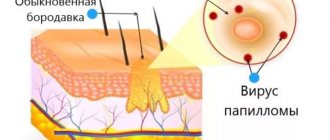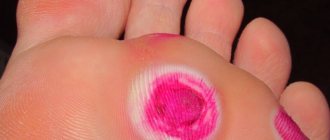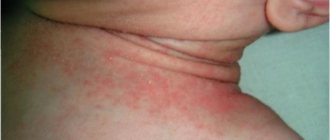What does it represent?
Keratopapilloma of the skin is a keratinized papilloma that has transformed into a keratoma. The neoplasm looks like a growth on the epidermis. At first it is simple pigmentation, which tends to grow rapidly. In a short time it becomes a full-fledged keratoma.
The disease usually appears in older people. Most often, a growth on the skin occurs in a person who has crossed the fifty-year threshold if he has a dry type of epidermis. Similar papillomas also occur in people over 40 years of age. Skin formations do not bother people younger than this age, since their immune system successfully copes with the pathology.
Places of localization of formations are open areas of the epidermis.
2.Classification
Keratomas are classified according to a number of characteristics:
- senile keratoma (gray-white growth on an open area of the body, prone to inflammation);
- seborrheic keratoma (the most dangerous type of growth, which turns brown over time, causes itching and peeling);
- horny keratoma (usually a strongly protruding, small diameter, but tall, dark-colored growth that can degenerate);
- solar keratoma (multifocal keratoma, most often affecting exposed skin in men over 40 years of age, dangerous for asymptomatic degeneration into cancer);
- follicular keratoma (growth on the scalp or upper lip, more common in women).
Visit our Dermatology page
Types of keratopapilloma
Keratomas are classified as follows:
- neoplasms that arise due to the penetration of various viruses into the body, which harden under the influence of ultraviolet radiation;
- seborrheic growths arising from keratosis.
Seborrheic growths have several stages of development:
- Dark spots . They are formed on the skin under the influence of ultraviolet radiation. They are brown spots that do not rise above the epidermis. Such formations are not accompanied by pain and do not cause discomfort.
- Papules . At this stage, the spots increase in size and rise above the level of the skin.
- Keratosis . White scales appear on the neoplasm, and the skin begins to peel off.
- Kerification of formation . The growth becomes hard and rises above the level of the skin. The neoplasm looks like a horn.
When a lump appears on the epidermis in older people, the doctor advises them to spend less time in the sun and not go outside without applying a protective cream. This will help avoid the development of a benign neoplasm into a malignant tumor.
Causes
Keratomas are not caused by the human papillomavirus. The appearance of a formation is associated with a malfunction of the entire body or internal organs, as well as any system. However, this is not the main reason for the development of the disease. Such skin papillomas occur due to exposure to sunlight. The reaction of the epidermis to ultraviolet radiation is a hereditary form of the disease.
The development of pathology is accelerated due to the following factors:
- taking certain medications for a long time;
- diseases of the gastrointestinal tract;
- disruption of the autonomic and endocrine systems;
- disruption of the process of intercellular metabolism;
- prolonged wearing of tight clothing made of synthetic materials;
- regular visits to the solarium;
- weakening of the body's defenses;
- unfavorable environment;
- deficiency of nutrients, in particular vitamin A.
Keratopapilloma, photos of the disease are presented on the Internet, usually develops in people with the following pathologies:
- autoimmune diseases, which include lupus erythematosus, multiple sclerosis and others;
- autosomal recessive diseases, in which a person’s growth slows down and there is a tendency to develop oncological pathologies;
- a rare genetic disease that causes nervous system disorders, growth retardation, problems with hearing, vision, epidermis, as well as premature aging;
- congenital absence of the pigment melanin, which is responsible for the color of hair, eyes and skin;
- an autosomal recessive disease in which skin lesions are observed.
Neoplasms of this type appear due to the death of the upper skin cells, which are called keratinocides. Dead cells gather together and form a compaction that rises above the epidermis.
Prevention and risk zone
People over 50 years of age are susceptible to age-related keratomas. Anyone over 40 is at risk of developing neoplasms of any type. In addition, hereditary predisposition and the presence of skin problems, for example, strong pigmentation or excessive dryness, influence the risk.
Preventive actions:
- You should choose food processing methods such as baking, stewing or boiling, and avoid frying in oil.
- Drink more water and natural herbal tea.
- Do not wear uncomfortable clothes that restrict movement and cause discomfort.
- Include purple berries, green tea, buckwheat, herbs, and citrus fruits in the menu. All these foods are rich in vitamin P.
- You should not spend a lot of time in open sunlight. On the beach, you must always use high-level protection products.
- Do not eat food containing artificial additives and carcinogens.
These preventative measures will help you avoid many problems, as well as maintain the beauty and health of your skin.
Possible complications
Keratopapilloma is a benign skin formation, so in itself it does not pose a threat to the body. Complications arise only due to mechanical damage to the growth. This may occur due to constant friction against the seams of clothing or due to the fact that the patient himself tries to tear off the formation.
As a result, the following complications arise:
- development of other skin pathologies;
- the appearance of fungus;
- the appearance of purulent formation;
- spread of keratopapillomas throughout the skin;
- penetration of various viruses and bacteria into the body.
If a keratopapilloma has been subjected to mechanical stress for a long time and begins to bleed, then there is a high risk of transforming the formation from benign to a malignant tumor. For this reason, such papilloma cannot be ignored. It is recommended to remove the keratoma to ensure that the formation does not become a malignant tumor.
Indications for senile wart removal
The decision to remove the tumor is made by the doctor together with the patient. If keratopapilloma causes only aesthetic problems, then it is not necessary to resort to surgery. But it is necessary to monitor the growth and condition of papilloma. But in some cases, the keratoma must be removed:
- When there are signs of tissue degeneration into malignant ones. This can be assumed by a sharp increase in the size of the wart, a change in color, and the appearance of bleeding or inflammation.
- The growth is located in an area where it experiences pressure from clothing or causes discomfort.
- Constantly injured.
- A group of papillomas occupies a large area of skin.
Keratopapilloma can be removed at the request of the patient without other indications.
Symptoms
Papilloma of this type first appears as a light brown spot. After some time, it begins to grow and rises above the epidermis. The spot then acquires a dark brown or red tone. The surface of the formation has small depressions. Keratopapilloma does not stop there. Education continues to grow in size. This papilloma has a significant elevation above the skin. The shape of the formation is round, diameter is up to 6 cm. The surface of the growth is covered with horny scales. When subjected to mechanical stress, they tear off, and the damaged surface begins to bleed.
Typically, papillomas of this type appear where the epidermis is not protected by clothing. Formations rarely appear on other areas of the skin, but such cases have been recorded. Papillomas rarely occur in one copy. Multiple formations are more common.
Diagnostics
If papillomas of this type occur, it is recommended to consult a doctor. The specialist will diagnose the keratoma and choose the appropriate treatment method.
Any problems related to the skin are dealt with by a dermatologist. For this reason, if there is a suspicion of keratopapilloma, it is recommended to contact this specialist. The doctor will interview and examine the patient, and then perform a dermatoscopy. The essence of this study is to examine the tumor particles under a microscope. This allows you to see the characteristic cysts and cornea of this type of papilloma. Histology of the formation is carried out after its removal.
If a malignant papilloma is suspected, the patient is referred to a dermato-oncologist. The specialist will prescribe seascopy and ultrasound. Based on these studies, a diagnosis will be made.
What is solar keratosis (senile keratomas)
Actinic keratosis (senile keratoma) is a skin reaction to excessive ultraviolet irradiation - a benign neoplasm due to clonal modifications of DNA in keratinocytes.
Statistics
- Occurs in every 4th person over 45 years of age;
- Accounts for 14% of all visits to a dermatologist;
- According to some authors, 60–80% of squamous cell skin cancer develops in areas of actinic keratosis.
The course is progressive with the possibility of degeneration into squamous cell skin cancer.
Clinical forms
- Erythematous,
- Keratotic,
- Papilomatous (warty),
- Horny (cutaneous horn),
- Pigmented,
- Proliferative,
- Solar cheilitis.
Treatment
Keratopapilloma, what it is was discussed above, and how to treat the formation - the doctor will tell you after examination and relevant research.
One of the methods of treating papilloma of this type is the local use of medications. Usually the doctor prescribes:
- antitumor drugs to prevent the transition of a neoplasm from a benign papilloma to a malignant tumor. Most often, the specialist prescribes Bleomycin and Prospidin;
- agents that slow down the development of keratomas . These include Solcoderm and colchamine ointment;
- corticosteroid drugs . Such drugs are prescribed to relieve inflammation and itching, as well as reduce peeling.
It is recommended to take multivitamins in conjunction with local therapy. Such drugs will replenish the deficiency of nutrients in the body and improve its defenses, which will have a positive effect not only on the condition of the epidermis, but also on the activity of all organs and systems.
The drug treatment method is only a prevention of the transformation of keratopapilloma into a malignant formation.
Removal methods
Removal of papillomas is carried out in the following cases:
- if the tumor appears on the face and causes aesthetic discomfort;
- keratopapilloma is constantly exposed to mechanical stress;
- the growth is accompanied by inflammation;
- there is a possibility of papilloma developing into a malignant formation;
- growths spread throughout the entire skin at high speed or combine into large formations that cause discomfort.
There are several methods for removing keratopapilloma:
- Surgically . This is one of the most reliable methods for removing growth. The essence of the procedure is cutting out the keratopapilloma using a scalpel. The disadvantage of this method of treatment is that scars remain at the site of the operation, which is unacceptable if the papilloma needs to be removed on the face.
- Laser removal of growth . The essence of the method is the impact on the affected areas of the epidermis with a laser. This method of treatment is effective, painless and safe. There are no traces left at the site where the wart was burned. After surgery, the risk of recurrence of the pathology is minimal. Laser removal can be performed on any part of the epidermis.
- Radiosurgery . Removal of papilloma is carried out without damaging the healthy epidermis. This method of treatment has proven itself to be positive. After removal of keratopapilloma, no traces remain on the skin. The risk of relapse of the pathology is minimal.
- Removal of keratopapilloma with liquid nitrogen . After this procedure, after seven days the growth disappears. The treatment does not go unnoticed. A small pink spot remains on the epidermis.
Folk remedies
If keratopapilloma is just beginning to grow, then you can use alternative medicine to get rid of the tumor. It is recommended to use such drugs only after consulting a specialist.
Aloe
Several of the fleshiest aloe leaves are cut from the bush, washed and put in the freezer for three days. After this, the plant is taken out and left to defrost. Then the leaves are cut and fixed on the affected epidermis with an adhesive plaster. The course of therapy is 21 days.
Potato
Peel fresh potatoes and grate them into a fine grater. Place the resulting puree on the affected area of the epidermis and leave for half an hour. Then remove the mixture and rinse the skin with warm water. The treatment period is 2-3 weeks.
Keratopapilloma is a neoplasm that causes aesthetic discomfort and can cause complications, including a malignant tumor. For this reason, the problem cannot be ignored and if it occurs, it is recommended to consult a doctor.
Reviews and results
Galina, 66 years old I discovered a thickening of an unpleasant color on my forehead 3 months ago. At first I didn’t even do anything, I thought everything would go away on its own. But the spot in front of my eyes grew to frightening proportions. I went to the doctor, he said that I needed to cut it. The operation was successful, thank God, without complications. One BUT - you constantly have to go to the hospital for dressings.
Peter, 47 years old I faced the following problem: at work I constantly wore a uniform that was very tight on my shoulders and neck. A stain with cracks, dense and dark, has formed. I applied lotions to my neck and rubbed it with oil. Then I tried Akerat cream. After a month and a half there was no trace left of the lump; it turned out to be a really good remedy.
Nadezhda, 53 years old I went to the sea in the summer and sunbathed for 5 hours every day. And now not only pigment spots have appeared, but also keratosis. The spots on my legs were very flaky and looked terrible. The hospital told me to get rid of it using a radio knife. I'm happy with the procedure, it didn't hurt at all, and there were no scars left.
If keratomas appear on the skin, you should not worry. Timely treatment will help avoid dangerous consequences, and methods for removing tumors are highly effective. An experienced doctor will select the most suitable option to combat the problem.










